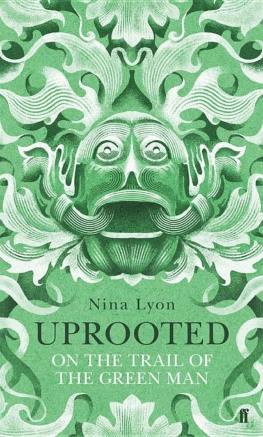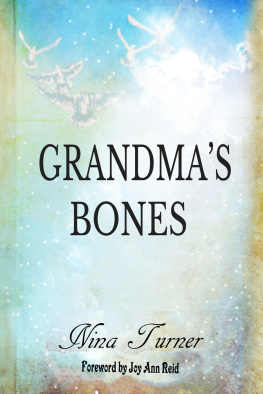Nina Lyon - Uprooted: On the Trail of the Green Man
Here you can read online Nina Lyon - Uprooted: On the Trail of the Green Man full text of the book (entire story) in english for free. Download pdf and epub, get meaning, cover and reviews about this ebook. year: 2016, publisher: Faber & Faber, genre: Religion. Description of the work, (preface) as well as reviews are available. Best literature library LitArk.com created for fans of good reading and offers a wide selection of genres:
Romance novel
Science fiction
Adventure
Detective
Science
History
Home and family
Prose
Art
Politics
Computer
Non-fiction
Religion
Business
Children
Humor
Choose a favorite category and find really read worthwhile books. Enjoy immersion in the world of imagination, feel the emotions of the characters or learn something new for yourself, make an fascinating discovery.
Uprooted: On the Trail of the Green Man: summary, description and annotation
We offer to read an annotation, description, summary or preface (depends on what the author of the book "Uprooted: On the Trail of the Green Man" wrote himself). If you haven't found the necessary information about the book — write in the comments, we will try to find it.
Uprooted: On the Trail of the Green Man — read online for free the complete book (whole text) full work
Below is the text of the book, divided by pages. System saving the place of the last page read, allows you to conveniently read the book "Uprooted: On the Trail of the Green Man" online for free, without having to search again every time where you left off. Put a bookmark, and you can go to the page where you finished reading at any time.
Font size:
Interval:
Bookmark:

For Felix and Lara, and all who lurk in the undergrowth
What seems to be the white noise of the wind is, on closer listen, both polyrhythmic and multi-tonal. There is a single background hum and, weaving around it, the rise and fall of other winds: sidewinds and crosswinds and eddies. The house is on a hill, or, to be more precise, on the head of a ridge running off a hill into the Wye Valley. You can therefore, on a clear day, see down the valley in both directions, and across the valley to the Hergest Ridge and, behind it, the Radnor Hills, which are sometimes dusted with snow. Behind the houses promontory is Little Mountain, which is not really a mountain, but a big hill.
You can see everywhere, and the wind can get everywhere. Perhaps because it comes from everywhere at once, channelled down the broad valley but refracted through many other places, it creates a cacophony, always altering, never resting. While the patter of windless rain is calming in its soft consistency, there is something rousing about the wind, which is not relaxing. It is like a restless chant.
It was after another white night of wind that I drove, sleep-deprived and in a condition not suited to adverse road conditions, along the length of the Golden Valley as it follows the path of the Dore down from the hills that loom above the Wye. The road was, in its better parts, a conduit for water flowing from one field to the next and, when it sloped, a waterfall. This was a good thing, for the movement of the water meant that it did not pool deeper. Red mud coursed along past abandoned cars left in last nights floods, which had, for the moment, subsided. The static bodies of water were the scary bits, because you did not know where they would end. There were fewer of these, but the road had been carved away at its edges, which fell aside like glacial moraine, and the road, like the washed-out cars, looked fragile. An unremarkable journey alters when its success cannot be taken for granted. The water was winning.
We live in an age controlled by humans and human technology. One current assumption, the pessimists, is that human technology is so efficient and invulnerable that it will, eventually, kill off the planet. The optimists take a different line, which is that human ingenuity will evolve to solve all problems regarding human survival. Both rest on the assumptions that human ingenuity is unique, for good or for bad, and that human technology is more robust and powerful than nature. It took a month of angry storms to make me consider this more critically than before.
There was something about the surfeit and force of elements that made me want to go back to Kilpeck, which is where I was headed. I felt as though the aggressions of the weather might make more sense there, or perhaps that Kilpeck would make more sense in the light of the storms.
Kilpeck is a village in Herefordshire, about twenty miles away from my home near Hay-on-Wye. The village itself might have come straight out of The Archers, a westerly Albion of rolling hills and well-kept pretty cottages and a smart-looking pub with good food. At its edge are two noteworthy things: a motte-and-bailey castle and a church, which is not really, to my mind, a church in any conventionally understood Christian sense at all.
In the eleventh century, the parishioners of Kilpeck would have been trying to understand their landscape and the weather that altered it as an expression of a greater will. As human endeavour moulded the land, with clearings and mounds and buildings, so it was moulded by the land, existing in conflict, and in symbiosis, with nature.
Our rational belief in a mechanistic world of things enables us to find effective ways of operating in it, and our ways of operating in it further build that belief. We seem to be very adept at shaping the world to our will, and think little of the idea that the will and the ways of humankind might fall prey to any entity other than our own self-destruction.
But this sustained attack from untamed nature together with a big cultural wave of environmental doom-tales had made me question our narrative of human progress, our sense that comfort can be gained from our capacity to build and improve our world. It all seemed a bit anthropocentric. People looked small on stormy days. Once upon a time, the storms would have been attributed to a pagan deity of some kind, or an angry Old Testament God.
When I was seven, I was politely excused from Sunday school on the basis that being a vociferous atheist was fine but poorly suited to its aims a gentle dismissal that leaves me with a residual fondness for the Church of England. I am not inclined towards religion, or superstition, or anything much that cant reveal itself empirically.
I was not in a mood for finding God or redemption, or, for that matter, its pagan equivalent. I was interested more in how to simply understand a relationship with nature and the land in which both were considered to be alive, and not just alive but conscious. I wanted to get into what I had come to think of as the Kilpeck headspace. There is a sense of godliness revealed in nature that characterises the architectural decoration and, I would venture, would once have characterised the creed of the Kilpeck church. I was starting to wonder if taking a worldview which encompassed the idea of a will that is everywhere, whether of God or object or ether, might actually be a more practical way of understanding the things that modern-day scientism sometimes doesnt.
The rain had stopped and the wet road, lit up in the first sunshine for weeks, glared its path to the village. The church stood, calm and flesh-pink in the new light, as though the storms had never happened. Behind it, through a yew-lined uphill avenue, the ditch around the castle motte had flooded into a moat, cutting it off apart from a foot of raised track. Rather than concealing the structure of the space, the water clarified its depths and heights and the even circle of the motte. Now that the rain had stopped and the sky was blue, its bright reflection shone in the flash moat.
Behind the castle tump, above the spiky tips of a pine forest, loomed the massif of the Black Mountains. Today the mountains were not black, but white with snow. As I drove back down the Golden Valley later, the snowline looked as though it were painted on in one vast stripe along the Cats Back. Birds sang from above the village. Beneath us, I thought I could hear a distant hum, or roar, and braced myself for revelation, but it was the A465.
The most famous thing about the Church of St Mary and St David at Kilpeck is probably the Sheela-na-gig carved among the corbels that encircle it. A woman baring her dilated vagina in an aggressive fashion is not the stuff we are led to believe that the Church, however early, is made of. But to see the Sheela-na-gig in isolation is to fall prey to our own post-Victorian prurience at such things she sits in a line of extraordinary carvings of animals and men, song and dance and food and love that look like a pagan celebration of the stuff of life.
The Kilpeck Sheela-na-gig is seen as a warning against the sins of the flesh. It is true that, with her bald head and staring eyes, she looks bellicose rather than buxom, as though shed glass you after a few drinks. But in the context of the other corbels it is very hard to see her as an aberrant warning against sin, because none of the others have that function.
As a point of comparison, the Abbaye dArthous is in the French Basque country, close to the Pyrenees, much in the same way that Kilpeck lies in the last flattish part of the Welsh Marches before they ascend into the Black Mountains. It was built at the same time, in the late twelfth century, and its corbels are similar in their Romanesque style and carving technique to those at Kilpeck. It is thought that the Herefordshire School of stonemasonry that graces Kilpeck and, somewhat less after desecrations and rebuilds, the nearby churches at Eardisley and Shobdon, consisted of a number of local craftsmen overseen by someone who had trained in France. There are, however, substantial differences in the subject matter.
Font size:
Interval:
Bookmark:
Similar books «Uprooted: On the Trail of the Green Man»
Look at similar books to Uprooted: On the Trail of the Green Man. We have selected literature similar in name and meaning in the hope of providing readers with more options to find new, interesting, not yet read works.
Discussion, reviews of the book Uprooted: On the Trail of the Green Man and just readers' own opinions. Leave your comments, write what you think about the work, its meaning or the main characters. Specify what exactly you liked and what you didn't like, and why you think so.











